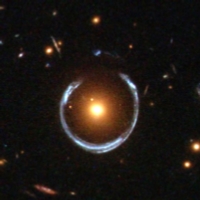Finding strong gravitational lenses using the ESA Euclid space telescope
Autumn 2014
Master Semester Project
Master Diploma
Project: 00280

As an optical lens does, a gravitational lens deflects light rays when they pass in
its vicinity. As a consequence, a distant galaxy seen along the line of sight to another
one will be seen distorted, sometimes to the point of forming an "Einstein Ring". This is
seen in figure enclosed (taken with the NASA-ESA Hubble Space Telescope) as a blue ring forming behind
a massive (yellowish) elliptical galaxy. Studying such objects is crucial for cosmology
and has profound implications on our understanding of galaxy formation: the size of the
observed ring directly measures the mass (including dark matter) of the lensing galaxy.
Only 300 such objects are known to date but up to 100000 are expected to be found
with the ESA Euclid space telescope, to be launched in 2019.
While Euclid will only fly in 2019, other data are already available and can be used
to carry out of first lens search.
We propose to design a wavelet-based (multi-scale and multi-orentation) detector that will find these objects in the database of the satellite.
The work is in direct collaboration with EPFL's laboratory of Astronomy (Dr. Courbin).
The work is in direct collaboration with EPFL's laboratory of Astronomy (Dr. Courbin).
- Supervisors
- Zsuzsanna Puspöki, zsuzsanna.puspoki@epfl.ch, 021 693 51 57, BM 4.139
- Michael Unser, michael.unser@epfl.ch, 021 693 51 75, BM 4.136